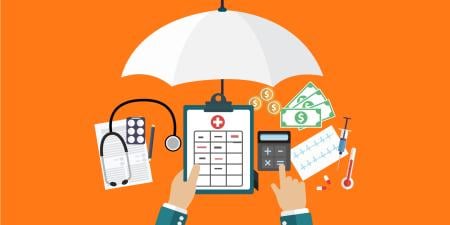Health care is expensive. People who need care but cannot afford it deal with this truth in a variety of ways; they may delay or forgo care, or they may seek care from alternative, lower-cost providers. Emerging research has shown that it is also common for people to go into debt—either to physicians and hospitals directly or to a third party such as a credit card company—to avail themselves of medical care.
Medical debt is surprisingly common. A recent national survey found that 1 out of 6 non-elderly adults—about 28 million people—had medical debt [1]. The risk of medical debt is greater for people without health insurance, but those who are insured are not immune; 15 percent of those who had insurance for all of the preceding 12 months reported having some medical debt. And 70 percent of all those with debt said they were insured at the time the debt was incurred [1]. Many of these people could be characterized as “underinsured,” meaning that they were nominally covered but inadequately protected [2].
Community-based research conducted by The Access Project, a national resource center for local organizations working to improve health care access, supports these data. In a 2000 study conducted in 24 communities around the country, almost half of the nearly 7000 uninsured respondents had unpaid medical bills or were in debt to a particular safety net facility in their community [3]. The Access Project’s 2005 study of low-income, insured taxpayers in 7 communities, again found that 46 percent had medical debt [4].
Medical debt has an impact on patient behavior. People with medical debt are far less likely to fill a prescription, see a specialist when needed, or visit a doctor or clinic for a medical problem. They are more likely to skip a needed test, treatment, or follow-up visit [1]. Among uninsured people who owed money to a community clinic or other safety net provider, one quarter said that having the debt would deter them from seeking care at that facility in the future [3].
While analyses of access to care often compare insured and uninsured groups, it appears that the care-seeking behavior of privately insured adults with medical debt is similar to that of uninsured people. On a number of standard access measures—skipping tests, not filling prescriptions, and postponing care—respondents to a national survey reported that medical debt presented nearly as high a barrier to access as having no access at all, even among insured people with a consistent place for care—a “medical home” [5].
Many of the debt-related reasons for doing without needed care are self-imposed: pride, embarrassment, or simply reluctance to add to the debt burden. Other pressures, though, are external. A physician, for example, might require a deposit or full payment in advance from patients who owe for past services. Some offices refuse services outright—sometimes to all family members, not just to the person with the bill—until past due balances are paid [6]. And many hospitals employ aggressive, punitive debt-collection practices—including outside collection agencies and lawsuits—that deter patients who are unable to pay promptly from seeking further care [7].
While there is a clear line connecting medical debt to access and, thus, to health, the effects of medical debt reach beyond access. A national survey found that large numbers of people with unpaid medical bills drain their savings, take on large credit card debt, borrow against their homes, and significantly change their lifestyles to pay down the bills [8]. In the Access Project’s 2005 community-based research, more than a quarter of survey respondents reported that medical debt had led to housing problems such as failure to qualify for a mortgage, inability to pay housing costs, and denial of application for rental. Many said it had damaged their credit ratings, which has long-term effects on the ability to accumulate assets, buy a car, or secure employment. Slightly more than half said they had health insurance at the time they received the services for which they owed money [4]. These financial problems may contribute to health problems because they compound the more direct health effects of access barriers resulting from medical debt [9].
The Physician’s Role: Professional Responsibility and Values
Should clinicians be concerned with this trend? Some might argue that it is better if physicians do not know patients’ financial circumstances and treat everyone equally without regard to their ability to pay. In an ideal world this argument might hold, but in the real world medical debt affects people’s access to care and, by extension, their health. Hence, physicians have a responsibility to act to reduce it. In his call to reinvigorate medical professionalism, David Rothman describes 2 ways for physicians to fulfill their professional responsibilities as they relate to reducing the problem of medical debt: commitment to the patient’s interests over the physician’s and civic engagement, ie, advocating for systemic change to improve health and health care [10]. The authors of “Physician-Citizens—Public Roles and Professional Obligations,” describe widening “domains of [physician] obligation,” that range from direct patient care, to access to care, and finally to socioeconomic issues like housing conditions or domestic violence that affect patients directly [11]. Because medical debt is a socioeconomic factor that has a direct influence on patients’ interests, these principles of professionalism charge physicians with a duty to help patients manage the problem.
Professional values dictate why physicians should be involved, but questions remain about what physicians can do to minimize medical debt. There is a range of solutions, from the level of the individual physician, to policy changes at the local level, to larger systemic change. Physicians should, at a minimum, be aware of their institution’s or office’s charity care policy, sliding scale provisions, or reduced bill payment options. On a local or national scale, the Community Catalyst organization offers principles to guide effective community advocacy on behalf of patients and families who need assistance in reducing medical debt. These principles include information about the specific eligibility criteria for charity care, making charity policies well known to the general public and to patients, allowing for reasonable payment plans, and covering all medically necessary services without a charge to the patient when appropriate [12]. At the institutional level, the American Hospital Association has issued guidelines on billing and collections for its members, encouraging them to adopt reasonable, equitable, and respectful policies and to communicate those policies clearly to patients [13]. Other community, institutional, and professional organizations have also published principles and guidelines in this area. Physicians should lead in disseminating and implementing these ideas and should work in partnership with active community organizations to improve health care access, coverage, and services.
Recognizing the significant health consequences of medical debt to patients’ health and health care access, physicians and other health professionals have a public responsibility to engage in making change on the individual, local, and national level.
References
-
Doty MM, Edwards JN, Holmgren AL. Seeing Red: Americans driven into debt by medical bills. Results from a national survey. Issue Brief (Commonw Fund). 2005;August:1-12.
-
Schoen C, Doty MM, Colins SR, Holmgren AL. Insured but not protected: how many adults are underinsured? Health Aff. June 14, 2005. Available at: http://content.healthaffairs.org/cgi/content/full/hlthaff.w5.289/DC1. Accessed February 1, 2006.
-
Andrulis D, Duchon L, Pryor C, Goodman N. Paying for Health Care When You’re Uninsured: How Much Support Does the Safety Net Offer? Available at: http://www.accessproject.org/medical.html#md_cams. Accessed February 1, 2006.
-
Seifert RW. Home Sick: How Medical Debt Undermines Housing Security. Available at: http://www.accessproject.org/medical.html#md_housing. Accessed February 1, 2006.
-
Hoffman C, Rowland D, Hamel EC. Medical Debt and Access to Health Care. Available at: http://www.kff.org/uninsured/7403.cfm. Accessed February 1, 2006.
-
Pryor C, Prottas J. Playing by the Rules but Losing: How Medical Debt Threatens Kansans’ Healthcare Access and Financial Security.Available at: http://www.accessproject.org/medical.html. Accessed February 1, 2006.
-
O’Toole TP, Arbelaez JJ, Lawrence RS; Baltimore Community Health Consortium. Medical debt and aggressive debt restitution practices: predatory billing among the urban poor. J Gen Intern Med. 2004;19(7):772-778.
-
Collins SR, Doty MM, Davis K, Schoen C, Holmgren AL, Ho A. The Affordability Crisis in U.S. Health Care: Findings from the Commonwealth Fund Biennial Health Insurance Survey. Available at: http://www.cmwf.org/publications/publications_show.htm?doc_id=221454. Accessed February 1, 2006.
- Jacoby MB. Does indebtedness influence health? A preliminary inquiry. J Law Med Ethics. 2002;30(4):560-571.
- Rothman D. Medical professionalism—focusing on the real issues. N Engl J Med. 2000;342(17):1284-1286.
- Gruen RL, Pearson SD, Brennan TD. Physician-citizens—public roles and professional obligations. JAMA. 2004;291(1):94-98.
-
Community Catalyst. Patient Financial Assistance Principles.Available at: http://www.communitycatalyst.org/resource.php?doc_id=355. Accessed January 24, 2006.
-
American Hospital Association. Hospital Billing and Collection Practices. Available at: http://www.hospitalconnect.com/aha/key_issues/bcp/content/guidelinesfinalweb.pdf. Accessed January 20, 2006.



